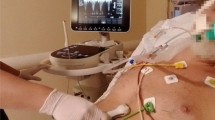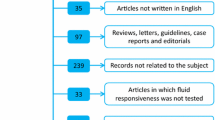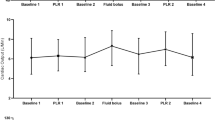Abstract
Purpose
The passive leg raising test (PLR) is a noninvasive method widely adopted to assess fluid responsiveness. We propose to explore if changes in the carotid flow assessed by echo-Doppler can predict fluid responsiveness after a PLR.
Methods
We conducted a performance diagnostic study in two intensive care units from Argentina between February and April 2022. We included patients with signs of tissular hypoperfusion that required fluid resuscitation. We labeled the patients as fluid responders when we measured, after a fluid bolus, an increase greater than 15% in the left ventricle outflow tract (LVOT) VTI in an apical 5-chamber view and we compared those results with the carotid flow (CF) velocity–time integral (VTI) from the left supraclavicular region in a semi-recumbent position and during the PLR.
Results
Of the 62 eligible patients, 50 patients (80.6%) were included. The area under the ROC curve for a change in CF VTI during the PLR test was 0.869 (95% CI 0.743–0.947). An increase of at least of 11% in the CF VTI with the PLR predicted fluid-responsiveness with a sensitivity of 77.3% (95% CI 54.6–92.2%) and specificity of 78.6% (95% CI 59–91.7%). The positive predictive value was 73.9% (95% CI 57.4–85.6%) and the negative predictive value was 81.5% (95% CI 66.5–90.7%). The positive likelihood ratio was 3.61 and the negative likelihood ratio was 0.29.
Conclusion
An increase greater than 11% in CF VTI after a PLR may be useful to predict fluid responsiveness among critically ill patients.





Similar content being viewed by others
Data availability
The data that support the findings of this study are available on request from the corresponding author. The data are not publicly available due to privacy or ethical restrictions.
References
Antiperovitch P, Iliescu E, Chan B (2017) Carotid systolic flow time with passive leg raise correlates with fluid status changes in patients undergoing dialysis. J Crit Care 39:83–86. https://doi.org/10.1016/j.jcrc.2017.02.017
Karadadaş S, Çorbacıoğlu ŞK, Çevik Y, Dağar S, Emektar E (2020) Assessment of the carotid artery Doppler flow time in patients with acute upper gastrointestinal bleeding. Turk J Emerg Med 20(1):35–41. https://doi.org/10.4103/2452-2473.276387
Girotto V, Teboul JL, Beurton A, Galarza L, Guedj T, Richard C, Monnet X (2018) Carotid and femoral Doppler do not allow the assessment of passive leg raising effects. Ann Intensive Care 8(1):67. https://doi.org/10.1186/s13613-018-0413-7
Cheong I, Amador EDO, Gómez RA, Vilariño FMÁ, Furche MA, Tamagnone FM (2023) Evaluating the utility of portal vein pulsatility index for detecting fluid unresponsiveness in the intensive care unit. J Cardiothorac Vasc Anesth. https://doi.org/10.1053/j.jvca.2023.05.039
Magder S (2011) Hemodynamic monitoring in the mechanically ventilated patient. Curr Opin Crit Care 17(1):36–42. https://doi.org/10.1097/MCC.0b013e32834272c1
Monnet X, Marik P, Teboul JL (2016) Passive leg raising for predicting fluid responsiveness: a systematic review and meta-analysis. Intensive Care Med 42(12):1935–1947. https://doi.org/10.1007/s00134-015-4134-1
Maizel J, Airapetian N, Lorne E, Tribouilloy C, Massy Z, Slama M (2007) Diagnosis of central hypovolemia by using passive leg raising. Intens Care Med 33(7):1133–1138. https://doi.org/10.1007/s00134-007-0642-y
Cheong I, Castro VO, Gómez RA, Merlo PM, Tamagnone FM (2022) A modified subcostal view: a novel method for measuring the LVOT VTI. J Ultrasound. https://doi.org/10.1007/s40477-022-00671-6
Cheong I, Bermeo M, Merlo PM, Tamagnone FM (2022) A new approach of non-invasive hemodynamic assessment by echocardiography in the intensive care unit: the right intercostal transhepatic window. Echocardiography 39(5):752–754. https://doi.org/10.1111/echo.15353
Chowhan G, Kundu R, Maitra S, Arora MK, Batra RK, Subramaniam R, Baidya DK, Trikha A (2021) Efficacy of left ventricular outflow tract and carotid artery velocity time integral as predictors of fluid responsiveness in patients with sepsis and septic shock. Indian J Crit Care Med 25(3):310–316. https://doi.org/10.5005/jp-journals-10071-23764
Ma IWY, Caplin JD, Azad A, Wilson C, Fifer MA, Bagchi A, Liteplo AS, Noble VE (2017) Correlation of carotid blood flow and corrected carotid flow time with invasive cardiac output measurements. Crit Ultrasound J. 9(1):10. https://doi.org/10.1186/s13089-017-0065-0
Peng QY, Zhang LN, Ai ML, Li L, Hu CH, Zhang YX, Liu W, Feng Q, Zou Y, Ai YH (2017) Chinese critical ultrasound study group. Common carotid artery sonography versus transthoracic echocardiography for cardiac output measurements in intensive care unit patients. J Ultrasound Med. 36(9):1793–1799. https://doi.org/10.1002/Jum.14214
Sidor M, Premachandra L, Hanna B, Nair N, Misra A (2020) Carotid flow as a surrogate for cardiac output measurement in hemodynamically stable participants. J Intensive Care Med 35(7):650–655. https://doi.org/10.1177/0885066618775694
Abu-Arafeh A, Jordan H, Drummond G (2016) Reporting of method comparison studies: a review of advice, an assessment of current practice, and specific suggestions for future reports. Br J Anaesth 117:569–575. https://doi.org/10.1093/bja/aew320
Polak JF, Alessi-Chinetti JM, Kremkau FW (2019) Doppler velocity estimates of internal carotid artery stenosis: angle correction parallel to the color doppler lumen versus parallel to the artery wall. J Ultrasound Med 38(12):3211–3218. https://doi.org/10.1002/jum.15029
Cheong I, Otero Castro V, Sosa FA, Tort Oribe B, Merlo PM, Tamagnone FM (2022) Carotid flow as a surrogate of the left ventricular stroke volume. J Clin Monit Comput. https://doi.org/10.1007/s10877-022-00938-7
Biais M, Vidil L, Sarrabay P, Cottenceau V, Revel P, Sztark F (2009) Changes in stroke volume induced by passive leg raising in spontaneously breathing patients: comparison between echocardiography and Vigileo/FloTrac device. Crit Care. 13(6):R195. https://doi.org/10.1186/cc8195
Barjaktarevic I, Chiem A, Cannesson M (2017) Time to correct the flow of corrected flow time. Crit Ultrasound J 9(1):18. https://doi.org/10.1186/s13089-017-0076-x
Judson PI, Abhilash KPP, Pichamuthu K, Chandy GM (2020) Evaluation of carotid flow time to assess fluid responsiveness in the emergency department. J Med Ultrasound 29(2):99–104. https://doi.org/10.4103/JMU.JMU_77_20
Marik PE, Levitov A, Young A, Andrews L (2013) The use of bioreactance and carotid doppler to determine volume responsiveness and blood flow redistribution following passive leg raising in hemodynamically unstable patients. Chest 143(2):364–370. https://doi.org/10.1378/chest.12-1274
Jalil B, Thompson P, Cavallazzi R, Marik P, Mann J, El-Kersh K, Guardiola J, Saad M (2018) Comparing changes in carotid flow time and stroke volume induced by passive leg raising. Am J Med Sci 355(2):168–173. https://doi.org/10.1016/j.amjms.2017.09.006
Kenny JS, Barjaktarevic I, Mackenzie DC, Elfarnawany M, Yang Z, Eibl AM, Eibl JK, Kim CH, Johnson BD (2022) Carotid artery velocity time integral and corrected flow time measured by a wearable Doppler ultrasound detect stroke volume rise from simulated hemorrhage to transfusion. BMC Res Notes 15(1):7. https://doi.org/10.1186/s13104-021-05896-y
Author information
Authors and Affiliations
Contributions
Conceptualization: IC; Methodology: IC; Formal analysis: IC; Investigation: IC, VOC, FAS, BTO, MFF; Writing—original draft preparation: IC; Writing—review and editing: IC, VOC; Supervision: IC, FMT, PMM.
Corresponding author
Ethics declarations
Conflict of interest
The authors have no relevant financial or non/financial interests to disclose.
Ethical approval
The study was conducted following the principles of the Helsinki Declaration and within the precautions established by ethical and legal standards. The study was approved by the Institutional Review Board and Ethic Committee of Clínica y Maternidad Suizo-Argentina (approval number 6598).
Consent to participate
Informed consent was obtained from all individual participants included in the study.
Consent to publish
The authors affirm that human research participants provided informed consent for publication of the images in Figs. 1, 2, 3, and 4
Additional information
Publisher's Note
Springer Nature remains neutral with regard to jurisdictional claims in published maps and institutional affiliations.
Rights and permissions
Springer Nature or its licensor (e.g. a society or other partner) holds exclusive rights to this article under a publishing agreement with the author(s) or other rightsholder(s); author self-archiving of the accepted manuscript version of this article is solely governed by the terms of such publishing agreement and applicable law.
About this article
Cite this article
Cheong, I., Otero Castro, V., Sosa, F.A. et al. Passive leg raising test using the carotid flow velocity–time integral to predict fluid responsiveness. J Ultrasound 27, 97–104 (2024). https://doi.org/10.1007/s40477-023-00824-1
Received:
Accepted:
Published:
Issue Date:
DOI: https://doi.org/10.1007/s40477-023-00824-1




